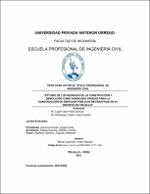Mostrar el registro sencillo del ítem
Estudio de los residuos de la construcción y demolición como agregado grueso para la construcción de espacios públicos recreativos en el distrito de Trujillo
| dc.contributor.advisor | Morán Guerrero, Víctor Manuel | |
| dc.contributor.author | Luján Vela, Fredy Samuel | |
| dc.contributor.author | Rodríguez Castro, José Franklin | |
| dc.creator | Luján Vela, Fredy Samuel | |
| dc.date.accessioned | 2021-06-21T15:20:32Z | |
| dc.date.available | 2021-06-21T15:20:32Z | |
| dc.date.issued | 2021 | |
| dc.identifier.uri | https://hdl.handle.net/20.500.12759/7688 | |
| dc.description.abstract | En la presente investigación denominada: “Estudio de los residuos de la construcción y demolición como agregado grueso para la construcción de espacios públicos recreativos en el distrito de Trujillo” tuvo como objeto buscar darle un valor agregado a un material que generalmente es botado y que genera acumulación en y contaminación con el tiempo, haciendo que forme parte de un producto altamente solicitado como es el concreto. Para ello se obtuvo material de escombros de concreto y se procedió a triturar hasta llegar a tamaños de agregado grueso de ½”, y se utilizaron materiales convencionales (de cantera), los cuales fueron caracterizados y el cemento tipo I de la marca Mochica - Pacasmayo. Se diseñó un concreto de 175 kg/cm2 y se elaboraron en total 45 muestras cilíndricas de 30 cm de altura y 15 cm de diámetro. Se realizaron las pruebas de resistencia a la compresión a 7, 14 y 28 días de curado de las probetas y se utilizaron dosificaciones de 50% y 100% de agregado reciclado de escombros en reemplazo del agregado grueso original. Llegando a la conclusión que el agregado reciclado de escombros disminuyó ligeramente la resistencia a la compresión pasando de 233.1 kg/cm2 de resistencia a 28 días de curado que se obtuvieron en las probetas patrón, a 200.1 kg/cm2 de resistencia que obtuvieron las probetas con 100% de agregado reciclado. Pero también se concluyó que es posible utilizar este tipo de material para elaborar concreto no estructural ya que todos los resultados superaron a la resistencia de diseño, dando la opción de viabilidad de implementar esta alternativa. | es_PE |
| dc.description.abstract | In the present investigation called: ““Study of construction and demolition waste as coarse aggregate for the construction of recreational public spaces in the Trujillo district““ had the objective of seeking to give added value to a material that is generally thrown away and that generates accumulation in and contamination over time, making it part of a highly requested product such as concrete. For this, concrete rubble material was obtained and crushed to reach ½ ”coarse aggregate sizes, and conventional materials (from quarry) were used, which were characterized and type I cement from the Mochica - Pacasmayo brand. . A 175 kg / cm2 concrete was designed and a total of 45 cylindrical samples of 30 cm in height and 15 cm in diameter were made. Compressive strength tests were carried out at 7, 14 and 28 days of curing of the specimens and dosages of 50% and 100% recycled rubble aggregate were used to replace the original coarse aggregate. Reaching the conclusion that the recycled rubble aggregate slightly decreased the compressive strength, going from 233.1 kg / cm2 of resistance to 28 days of curing that were obtained in the standard specimens, to 200.1 kg / cm2 of resistance that the specimens obtained with 100% recycled aggregate. But it was also concluded that it is possible to use this type of material to make non-structural concrete since all the results exceeded the design resistance, giving the option of feasibility of implementing this alternative. | en_US |
| dc.description.uri | Tesis | es_PE |
| dc.format | application/pdf | es_PE |
| dc.language.iso | spa | es_PE |
| dc.publisher | Universidad Privada Antenor Orrego | es_PE |
| dc.relation.ispartofseries | T_CIVIL_1956 | |
| dc.rights | info:eu-repo/semantics/openAccess | es_PE |
| dc.rights.uri | https://creativecommons.org/licenses/by/4.0/ | es_PE |
| dc.source | Universidad Privada Antenor Orrego | es_PE |
| dc.source | Repositorio Institucional - UPAO | es_PE |
| dc.subject | Agregado Reciclado | es_PE |
| dc.subject | Concreto No Estructural | es_PE |
| dc.title | Estudio de los residuos de la construcción y demolición como agregado grueso para la construcción de espacios públicos recreativos en el distrito de Trujillo | es_PE |
| dc.type | info:eu-repo/semantics/bachelorThesis | es_PE |
| thesis.degree.level | Titulo Profesional | es_PE |
| thesis.degree.grantor | Universidad Privada Antenor Orrego. Facultad de Ingeniería | es_PE |
| thesis.degree.name | Ingeniero Civil | es_PE |
| thesis.degree.discipline | Ingeniería Civil | es_PE |
| dc.subject.ocde | https://purl.org/pe-repo/ocde/ford#2.01.00 | es_PE |
| renati.advisor.orcid | https://orcid.org/0000-0001-8125-7462 | es_PE |
| renati.author.dni | 42538096 | |
| renati.author.dni | 44270436 | |
| renati.advisor.dni | 60241113 | |
| renati.type | https://purl.org/pe-repo/renati/type#tesis | es_PE |
| renati.level | https://purl.org/pe-repo/renati/level#tituloProfesional | es_PE |
| renati.discipline | 732016 | es_PE |
| renati.juror | Alanoca Quenta, Angel Fredy | |
| renati.juror | Galicia Guarniz, William Conrad | |
| renati.juror | Vejarano Geldres, Augusto Alejandro | |
| dc.publisher.country | PE | es_PE |
Ficheros en el ítem
Este ítem aparece en la(s) siguiente(s) colección(es)
-
Ingeniería Civil [1149]


